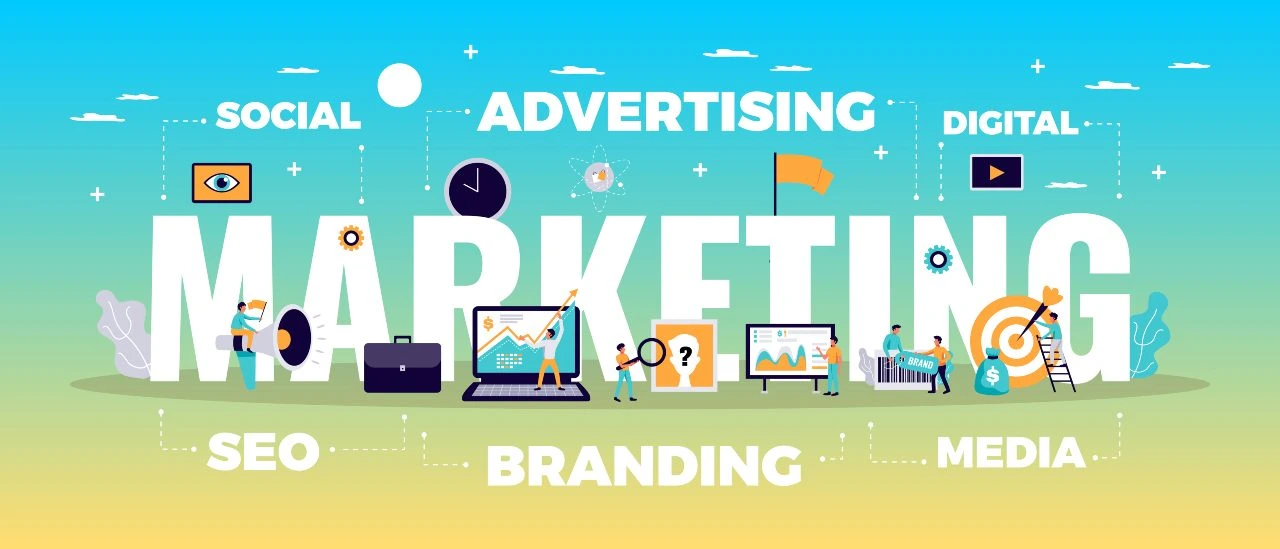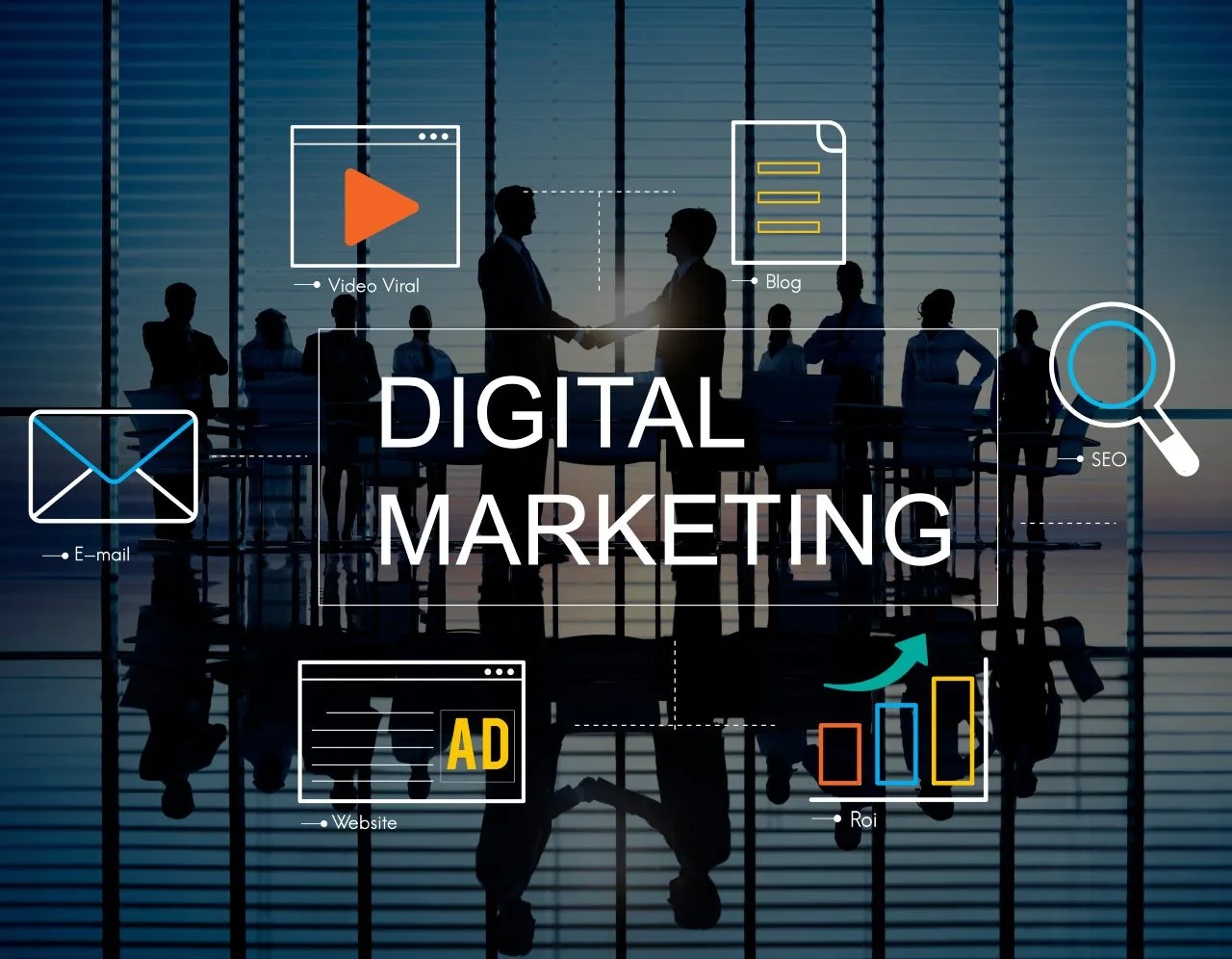Listen to article
Are you ready for 2025? Because the mobile revolution isn’t just coming—it’s already here and reshaping the digital landscape as we know it. As consumers spend increasing amounts of time on smartphones and tablets, businesses must adapt to mobile-first marketing strategies to stay relevant and competitive.
But what exactly does “mobile-first” mean for SEO, e-commerce, and content creation? It goes beyond simply having a responsive website. It requires a deep understanding of mobile user behavior, a commitment to personalized experiences, and a willingness to leverage cutting-edge technologies like AI.
In this data-rich article, we’ll dive into key statistics and trends that define the mobile-first era, offering actionable tips and strategies to help you thrive in this dynamic environment.
AI for Hyper-Personalized Mobile Marketing
In a world where consumers increasingly demand tailored experiences, AI has emerged as the cornerstone of modern mobile marketing strategies. No longer limited to simple automation, artificial intelligence now drives hyper-personalization, making it possible for brands to interact with their audiences at the right time, through the right channel, and with the right message. From creating dynamic content to predicting customer behaviors with remarkable accuracy, AI-powered tools are reshaping how businesses connect with mobile-first audiences.
- AI-driven personalization is set to dominate mobile marketing, allowing brands to craft uniquely tailored content based on individual user preferences and online behavior. Source
- AI tools streamline content creation, enabling marketers to produce high-quality, targeted content faster and at scale. Source
- 67% of small businesses now adopt AI for content marketing and SEO, highlighting its growing accessibility and essential role in achieving marketing success. Source
- AI enables businesses to deliver personalized experiences across every touchpoint, leveraging predictive analytics to enhance customer retention and satisfaction. Source
- More than half of marketers are already using AI to optimize copywriting for email marketing, organic search, and social media campaigns. Source
Key Takeaway
AI’s integration into mobile marketing isn’t just an efficiency booster—it’s a game-changer in delivering content that feels personal and relevant.With mobile usage projected to account for over 70% of web traffic in 2025 and click-through rates on mobile ads consistently outperforming desktop, mobile marketing stats and trends highlight the urgency for brands to optimize for mobile-first experiences. However, the key to unlocking its full potential lies in going beyond basic automation and diving into tools that enable real-time insights and adaptive messaging. As customers increasingly expect interactions that cater to their unique needs, marketers who embrace AI-driven strategies will find themselves better positioned to build loyalty and maximising digital marketing ROI.
Pro Tip:
Start small with AI-powered tools—experiment with dynamic email content or predictive product suggestions. As you become more comfortable, scale up by implementing advanced AI solutions for audience segmentation, campaign optimization, and real-time engagement triggers.
Mobile Usage Redefines Online Behavior and SEO Priorities
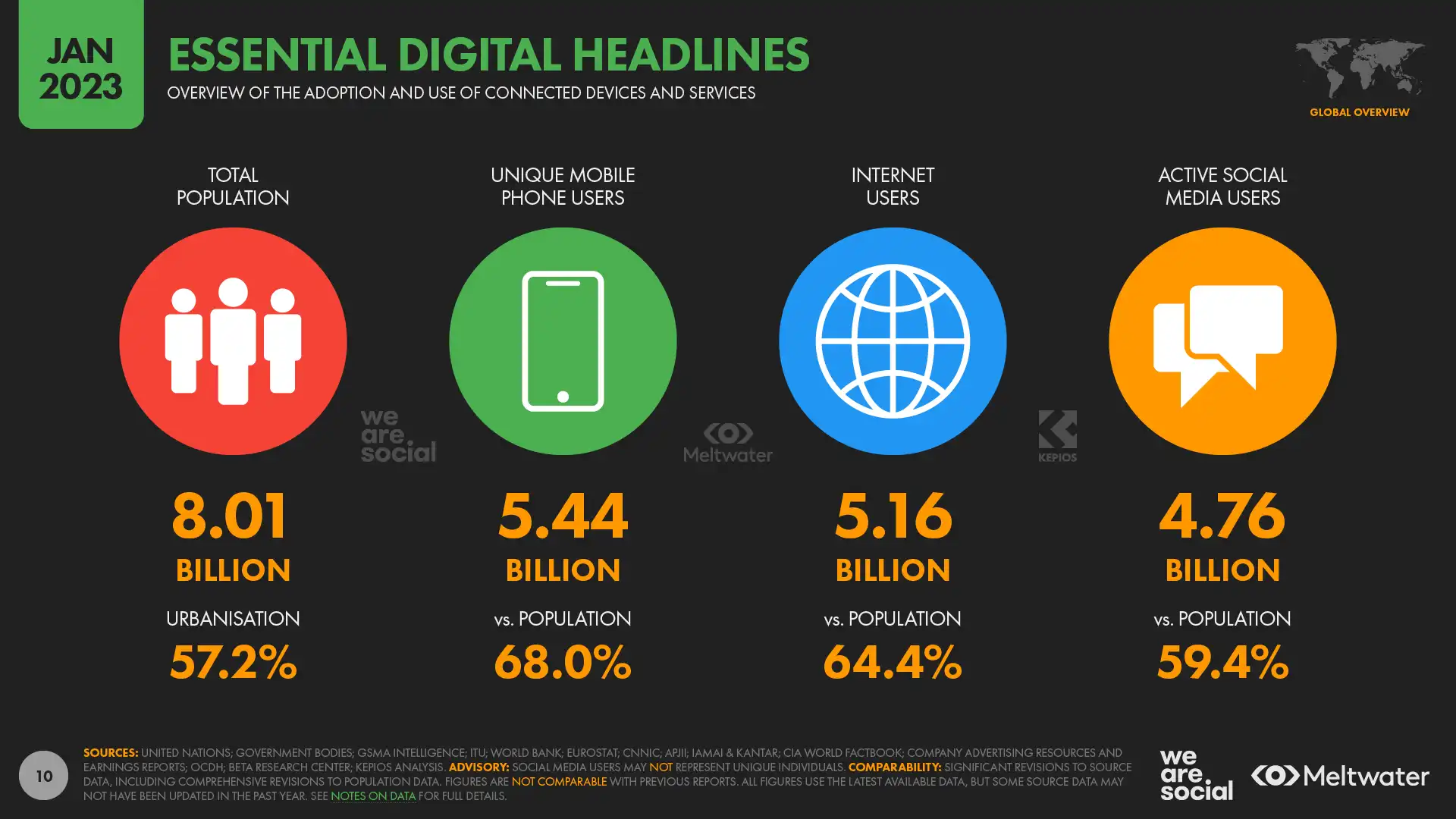
Source: DatarReportal
The shift to mobile as the dominant platform for web traffic isn’t just a trend—it’s a complete transformation in how audiences engage with digital content. For businesses, it’s no longer enough to treat mobile optimization as an option; it’s an absolute necessity to thrive in a competitive digital landscape. As mobile usage grows, consumer expectations around speed, functionality, and user experience are at an all-time high, forcing brands to adapt their SEO strategies and overall online presence to keep up.
- Mobile devices account for approximately 59% of total internet traffic worldwide. Source
- As of early 2023, 57.08% of internet traffic originated from mobile devices. Source
- Mobile devices account for 50.84% of all online visits worldwide, surpassing desktops at 46.39%. Source
- Mobile’s share of total website traffic has risen from 31.7% in Q1 2018 to 58.33% in Q1 2023. Source
- Over the past five years, desktop traffic share has decreased from approximately 66% to 41%. Source
- First-time app installations are projected to reach 183.7 billion globally in 2024. Source
Key Takeaway
The sharp rise in mobile usage highlights a fundamental truth: consumers have made the leap to mobile, and brands must follow suit or risk irrelevance. A mobile-first approach isn’t limited to having a responsive website; it’s about delivering an experience that meets user needs—quick load times, intuitive navigation, and seamless functionality across devices. Mobile-first indexing from search engines like Google only underscores the importance of this shift. With user expectations ever-evolving, businesses should invest in progressive mobile strategies, whether that means enhancing mobile site speed, prioritizing app experiences, or crafting content that resonates within the mobile-first environment.
For small businesses looking to stay competitive in this mobile-first ecosystem, leveraging digital marketing strategies for small businesses can provide a comprehensive roadmap to optimize their online presence. From SEO to mobile-friendly content creation, integrating these strategies ensures that businesses can meet the demands of a mobile-driven audience while maintaining a competitive edge in their industry.
Pro Tip:
Stay ahead of the competition by leveraging tools like Google’s Mobile-Friendly Test to identify potential optimization gaps. Additionally, experiment with AMP (Accelerated Mobile Pages) to improve mobile site speed and consider integrating mobile-exclusive features such as click-to-call buttons, simplified forms, or location-based personalization to elevate the user experience.
Decoding Mobile and Desktop User Behavior for Better Digital Strategies
In our multi-device world, user behavior varies significantly between mobile and desktop platforms, and these differences can’t be overlooked by marketers striving for optimal engagement. While mobile usage dominates in terms of sheer volume, desktop still leads in areas like conversions and time spent on-site. This divergence highlights the importance of creating device-specific strategies to meet users where they are and deliver the best possible experience.
- Desktop users visit an average of 3.95 pages per session, compared to 2.67 for mobile users and 3.21 for tablet users. Source
- Conversion rates on desktop are notably higher, hitting 3.7%, while mobile conversions trail at just 2.2%. Source
- Desktop users spend approximately 40% more time browsing websites than their mobile counterparts. Source
- Mobile devices suffer the highest global bounce rate at 52.11%, surpassing both desktop and tablet. Source
Key Takeaway
The stark contrast between mobile and desktop usage behaviors underscores the need for businesses to adopt a dual-optimization mindset. Mobile’s convenience makes it the go-to device for quick searches and on-the-go browsing, but desktop’s higher engagement and conversions make it indispensable for deeper interactions. To grow in 2025’s competitive digital landscape, businesses must balance speed, accessibility, and content depth across all devices.
Pro Tip:
Leverage heatmaps and session recordings to identify friction points for both mobile and desktop users. Use this data to refine your site’s navigation, CTAs, and page load times, ensuring each device provides a seamless user experience.
The Rise of Mobile as the Shopping Powerhouse
Smartphones have transformed from communication tools to digital marketplaces, empowering consumers to shop anytime, anywhere. With mobile devices emerging as the preferred channel for e-commerce, businesses that fail to adapt risk falling behind. The numbers tell a compelling story about the evolution of mobile commerce and its undeniable influence on consumer behavior.
- In 2022, global mobile commerce sales surpassed $4 trillion, accounting for over 28% of the total e-commerce market. Source
- Mobile devices accounted for approximately 47% of all online transactions in 2024, with projections estimating this share will climb to 62% by 2025. Source
- Consumers are increasingly drawn to shopping apps, spending an average of 19.3 hours per month on them in 2022—a significant 15% increase from the previous year. Source
Key Takeaway
Shoppers today expect businesses to meet them where they spend the majority of their digital time: on their phones. This shift toward mobile commerce is more than a convenient trend—it’s a change in consumer expectations for fast, frictionless, and on-the-go shopping experiences. Forward-thinking brands need to look beyond simply having a mobile presence and instead focus on truly optimizing the experience for mobile users.
Pro Tip:
Leverage advanced mobile features such as one-click checkout, personalized app notifications, and streamlined navigation to ensure your mobile shopping experience not only meets but exceeds user expectations.
Mobile Payments: A Game-Changer for E-Commerce
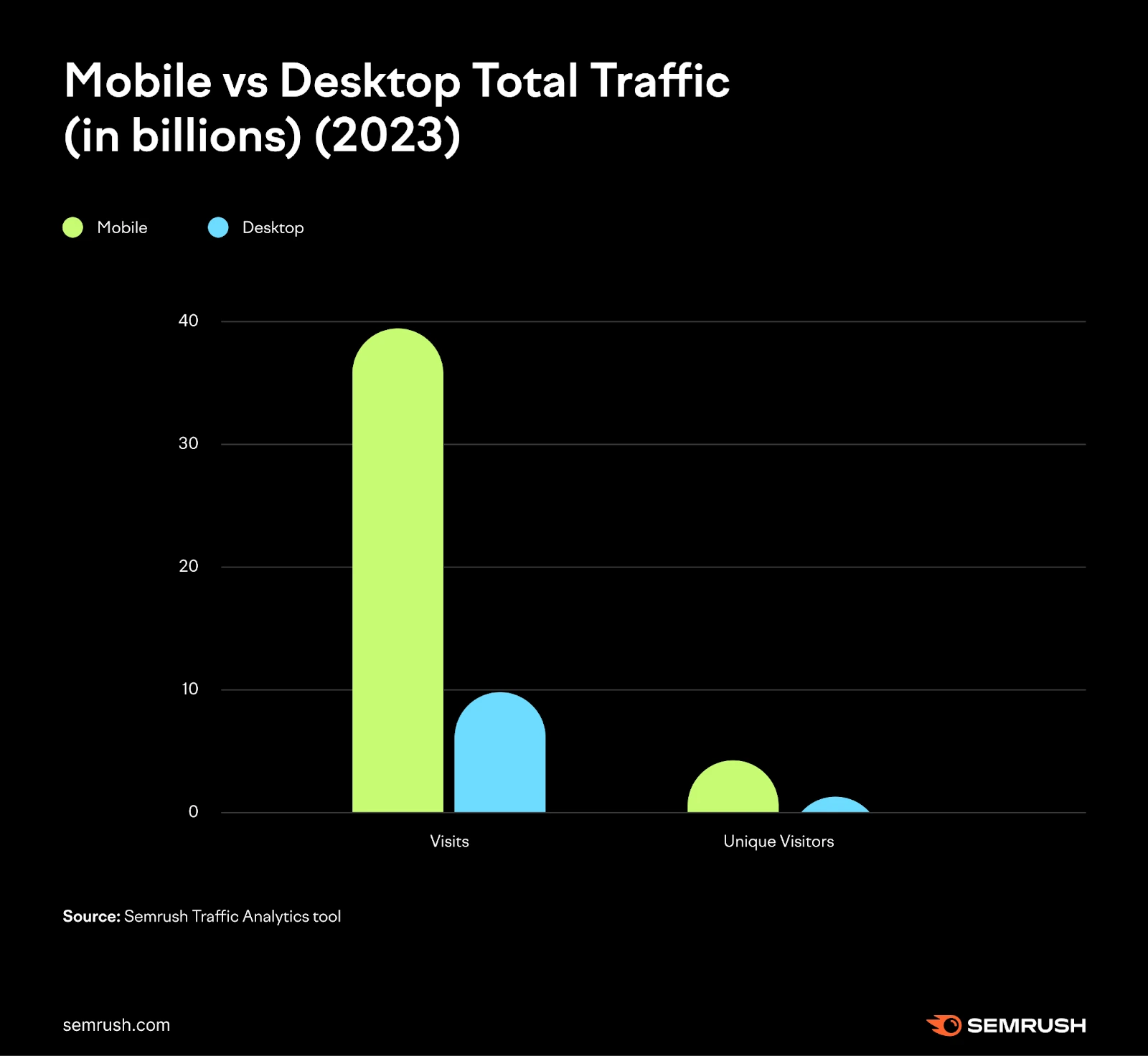
Source: Semrush
Mobile payments aren’t merely a convenience—they’re now an expectation. As consumers increasingly prioritize seamless experiences, having robust mobile payment options can be the difference between a completed transaction and an abandoned cart. Today’s landscape isn’t just about accepting payments; it’s about building trust, enhancing convenience, and ensuring security to meet tech-savvy consumer demands.
- The number of mobile payment users worldwide is projected to exceed 1.31 billion by 2023, demonstrating a global shift toward mobile wallets and next-gen payment technologies. Source
- Businesses are moving beyond traditional payment methods, integrating options like cryptocurrency, buy-now-pay-later (BNPL) solutions, and loyalty rewards to deliver a future-forward shopping experience. Source
The growing reliance on mobile payments is reshaping how businesses approach customer transactions. Beyond convenience, investing in secure, fast, and flexible mobile payment systems allows companies to build stronger customer relationships, reduce cart abandonment rates, and stay competitive in a mobile-first marketplace.
Pro Tip:
To ensure you’re ahead of the curve, focus on building trust with transparent payment policies and fortified security measures, such as biometric authentication. Pair this with exclusive offers, like app-only discounts or bonus loyalty points, to encourage customers to embrace mobile payments and keep them coming back for more.
Streamlining Mobile Checkout to Fuel E-commerce Success
Mobile commerce is no longer a secondary channel—it’s the backbone of online shopping today. Yet, despite its undeniable growth, mobile cart abandonment rates remain a significant challenge for retailers. The convenience of shopping from a smartphone is often overshadowed by friction points such as clunky checkouts, insufficient product visualization, and navigation hurdles. To retain customers in this competitive space, brands must adopt cutting-edge tools and strategies to ensure the mobile experience is not only seamless but also engaging and intuitive.
- Key mobile pain points, such as small screen sizes, limited product details, and disruptive multi-step authentication processes, significantly drive cart abandonment. Source
- Introducing saved payment methods or tokenized checkouts reduces friction by eliminating redundant authentication, making checkout faster and more user-friendly. Source
- AI-powered intent-based recommendations can guide shoppers toward personalized product choices, boosting both satisfaction and conversions. Source
- AR try-on tools allow mobile shoppers to visualize products—like furniture in their home or clothing they can “wear” digitally—bridging the gap between physical and virtual retail. Source
- Apparel brands are leveraging apps that superimpose clothing onto user images, enabling customers to see how items would look in various settings. Source
- Ensuring seamless transitions between digital channels, such as moving from an online chat to a phone call for support, offers a more cohesive and frustration-free journey. Source
- By addressing the barriers to mobile checkout, businesses can tap into the growing preference for mobile shopping, driving both revenue growth and long-term customer loyalty. Source
Key Takeaway
The mobile shopping experience is where brand loyalty is won or lost. Given the increasing dominance of smartphones in e-commerce, businesses that fail to prioritize smooth, engaging, and innovative mobile experiences risk losing customers to competitors that do. From AI-driven recommendations that anticipate user needs to AR tools that replicate in-store interactions, retailers have powerful tools at their disposal to reimagine their mobile strategies. Addressing friction points—no matter how small—can make the difference between an abandoned cart and a loyal customer.
Pro Tip:
Go beyond solving immediate pain points. Regularly test and optimize your mobile checkout flow, and integrate emerging tech like AI or AR to create a dynamic, forward-thinking shopping experience that adapts to evolving consumer expectations.
AI in Mobile Commerce and Customer Support
As mobile devices continue to dominate how consumers shop and interact with brands, businesses are turning to AI to meet these heightened expectations. AI is no longer just a competitive edge—it’s becoming a necessity to deliver personalized, frictionless, and customer-centric experiences at scale. From streamlining customer service through intelligent chatbots to dynamically tailoring content for individual users, AI is reshaping the e-commerce and service landscape in ways that were unimaginable just a few years ago. Here’s a closer look at how AI is powering this mobile-first revolution:
- The global chatbot industry is projected to grow significantly, from approximately $5.4 billion in 2023 to $15.5 billion by 2028. Source
- AI-driven personalization enhances user experience by analyzing vast amounts of data to predict resonant content or offers, leading to increased user engagement, higher conversion rates, and improved customer loyalty. Source
- AI facilitates dynamic content that adjusts in real-time based on user interactions, such as e-commerce websites modifying their homepage content based on a user’s past browsing behavior. Source
- AI enables predictive analytics, allowing brands to forecast consumer trends and optimize marketing campaigns, including personalized push notifications or email recommendations to users likely to convert. Source
- Chatbots can address customer concerns and answer real-time questions through natural language processing (NLP) and machine learning. Source
- Chatbots boost customer engagement, improve satisfaction, and drive sales by offering support and generating leads through websites or social media platforms. Source
Key Takeaway
With AI’s ability to deliver hyper-personalized, data-driven insights and instant customer service, businesses can unlock immense opportunities in both e-commerce and customer support. However, the real game-changer lies in adaptability—brands must experiment and refine their AI strategies to meet shifting behaviors and preferences. Companies that fail to integrate AI-powered solutions risk losing out to competitors who are successfully creating seamless shopping and service experiences on mobile platforms.
Pro Tip:
Don’t stop at basic chatbot functionality. Elevate your game by combining AI-driven chatbots with predictive analytics to deliver tailored recommendations and proactive customer support. Platforms like Drift, Zendesk, or LivePerson enable businesses to customize chatbot workflows for better engagement, retention, and conversions.
Growth of Mobile Advertising
As consumer behavior continues to shift towards mobile-first interactions, businesses are rapidly pivoting their advertising strategies to meet audiences where they are—on their smartphones. From scrolling through social media to binge-watching short-form videos, mobile platforms are dominating daily activities, making them a goldmine for advertisers. This transformation isn’t just about higher engagement; it’s about rethinking how advertising dollars are spent to stay competitive in a crowded digital marketplace.
- Worldwide mobile ad spending is projected to reach a staggering $402 billion in 2024, marking an 11% increase from the previous year, largely driven by the popularity of short-form videos and video-sharing apps. Source
- The U.S. is at the forefront, with mobile ad spending expected to surpass $216 billion in 2024, up from $194.8 billion in 2023, although the growth rate is slightly slower at 11.1% compared to the previous year’s 14.5%. Source
- The United States leads in mobile ad spending, exceeding $200 billion annually, followed by China, which spends nearly $150 billion each year. Source
- Projections indicate that mobile will command 70% of all ad spending by 2028, underscoring its growing importance. Source
Key Takeaway
The rise of mobile advertising isn’t just a numbers game—it’s a reflection of where consumers are spending their time and attention. With mobile ad formats like in-app ads, shoppable videos, and location-based targeting becoming more sophisticated, advertisers now have the tools to create more personalized and impactful campaigns. Businesses that fail to capitalize on this momentum risk losing relevance in an environment that increasingly prioritizes mobile-first interactions.
Pro Tip:
Don’t just invest in mobile ads—strategize for innovation. Experiment with new ad formats, leverage data-driven insights for hyper-targeted campaigns, and stay attuned to platform-specific trends, like the rise of immersive ads on TikTok or AI-driven personalization on Instagram. Integrating a B2B website strategy into your overall marketing plan can also ensure your mobile-first campaigns align seamlessly with your business goals, helping you capture and retain your target audience. Staying agile in this fast-evolving space can help you maximize ROI and future-proof your advertising efforts.
The Rise of Predictive AI in Mobile Advertising: How It’s Revolutionizing Customer Engagement
The future of mobile advertising is more than just delivering ads—it’s about delivering the right message at the perfect moment. AI-powered personalization combined with predictive analytics is fundamentally changing how brands connect with users, offering unprecedented insights into customer behavior. In an ever-competitive mobile-first landscape, where consumers demand relevance and immediacy, the ability to forecast needs and preferences gives businesses a decisive edge.
- Advertisers can leverage AI and ML to analyze vast amounts of data, gaining insights into user preferences and behaviors for more targeted ad campaigns. Source
- Predictive analytics, powered by AI, will analyze historical data on user interactions, purchase patterns, and demographics to predict future behavior and preferences. Source
- AI’s role is expanding beyond basic personalization to predictive analytics, anticipating customer needs before they are even realized. Source
- E-commerce brands can utilize AI to predict when a customer might need a specific product based on purchase history, browsing behavior, and seasonality, enabling tailored recommendations and offers. Source
Key Takeaway
As predictive AI reshapes the advertising landscape, it’s no longer enough to react to user behavior—it’s about anticipating it. By predicting what customers need, even before they know it themselves, brands can build deeper connections, foster loyalty, and significantly improve ROI. Beyond just increasing conversions, this approach enhances the customer experience by making interactions feel effortless and hyper-relevant. For marketers in 2025, the question isn’t whether to adopt predictive AI but how quickly they can implement it to stay competitive.
Pro Tip:
Harness data creatively! Combine predictive models with real-time user inputs—like location or time of day—to craft dynamic campaigns that resonate on an even deeper level. Experimentation and refinement are key to uncovering the full potential of AI-driven insights.
How AI-Driven Geotargeting is Redefining Location-Based Marketing Strategies
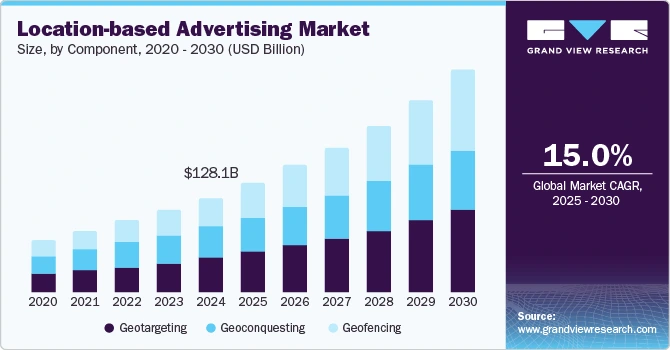
Source: Grand View Research
The integration of AI in geotargeting has dramatically reshaped how businesses approach mobile marketing. By blending real-time location data with behavioral insights, brands can now deliver hyper-relevant ads that resonate with users’ immediate contexts. This precision not only enhances user engagement but also translates into measurable foot traffic and conversions, making geotargeting an essential tool in the competitive mobile-first landscape.
- The global location-based advertising market, valued at over $62 billion USD in 2019, is projected to grow at a compound annual rate exceeding 17% from 2022 to 2027. Source
- AI-enhanced geotargeting empowers brands to deliver highly context-driven ads, leveraging real-time data to combine a user’s location, preferences, and behaviors for ultimate ad relevance. Source
- Location targeting can significantly boost in-store visits, as evidenced by Coach’s successful campaign, which drove thousands of customers to its physical stores through strategic geotargeting efforts. Source
Key Takeaway
AI-powered geotargeting isn’t just a buzzword—it’s a game-changer for brands looking to bridge the gap between digital engagement and offline interactions. By tapping into the power of real-time data and advanced algorithms, businesses can provide value at the perfect moment, creating personalized experiences that drive both loyalty and sales.
Pro Tip:
Take geotargeting to the next level by layering in predictive analytics to anticipate customer needs. For example, use AI to analyze peak foot traffic times or seasonal trends and craft campaigns that align with your audience’s habits, maximizing both timing and relevance.
Elevating Mobile Engagement with Precision and Connectivity
As mobile usage continues to dominate, user expectations for seamless, relevant, and engaging experiences across devices are reaching new heights. For brands to thrive, the focus must shift from blanket messaging to strategies that align with today’s hyper-connected customer journeys. This involves understanding not just where users are but how and when they interact with your content—and meeting them with the right message at exactly the right moment.
- Advertisements are becoming more contextually aware, appearing at moments when they are most likely to resonate with the consumer, such as travel ads showing while a user is browsing a travel blog. Source
- Advertisers are leveraging cross-device marketing to track and understand user interactions across smartphones, tablets, desktops, and other connected devices, enabling more precise targeting and personalized messaging. Source
- Advanced attribution models, including multi-touch attribution and probabilistic modeling, offer insights into the effectiveness of each touchpoint in the conversion path, enabling advertisers to optimize budget allocation and maximize ROI. Source
Key Takeaway
To stand out in a crowded mobile-first ecosystem, businesses must bridge the gap between contextual relevance and cross-device strategies. The winning formula lies in leveraging technology to deliver tailored messaging while maintaining the human touch users crave.
Pro Tip:
Implement AI-powered analytics and attribution tools to deepen your understanding of the customer journey, and don’t shy away from experimenting with predictive models to stay one step ahead of user needs.
Conclusion
The shift to mobile-first marketing is no longer a choice—it’s a necessity. As the data reveals, mobile devices dominate internet usage, e-commerce, and even advertising, making them the central touchpoint for connecting with today’s consumers. Whether it’s leveraging AI for personalized experiences, optimizing mobile SEO, or creating seamless e-commerce journeys, the strategies highlighted throughout this article underscore one key takeaway: businesses that prioritize mobile-first approaches are better positioned to capture attention, drive engagement, and foster loyalty.
But it’s not just about adapting to trends—it’s about staying ahead of them. With innovations like AI-powered geotargeting, predictive analytics, and AR-enhanced shopping experiences, the opportunities for differentiation are vast. By partnering with specialized SEO services, brands can ensure their mobile-first strategies are not only technically sound but also strategically aligned to maximize visibility and performance across all digital touchpoints. The brands that embrace these technologies and craft tailored, frictionless experiences will define not just the future of mobile marketing but the future of digital commerce as a whole.
Are you ready to align your strategies with the mobile-first era? Our full-service marketing experts are here to help you navigate this transformative landscape. Reach out today for a free quote and unlock the potential of mobile-first marketing for your business.
About Mobile-First in 2025: How User Behavior is Reshaping SEO, E-Commerce, and Content Strategy
This guide was written by the Scopic Studios team and reviewed by Araksya Hakobjanyan, SEO Lead at Scopic Studios.
Scopic Studios delivers exceptional and engaging content rooted in our expertise across marketing and creative services. Our team of talented writers and digital experts excel in transforming intricate concepts into captivating narratives tailored for diverse industries. We’re passionate about crafting content that not only resonates but also drives value across all digital platforms.
Note: This feature blog’s image are sourced from Freepik.
































































































































































































